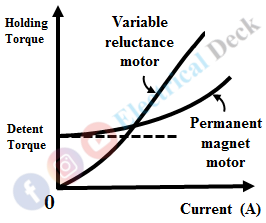In the last article, we have discussed different types of stepper motors with their constriction and working principles. Now, let us see the characteristics of a stepper motor. The stepper motors characteristics under stationary and running conditions that makes choice for different applications are,
- Static characteristics, and
- Dynamic characteristics.
Static Characteristics :
Static characteristics of a stepper motor are obtained at a stationary position. The static characteristics of the stepper motor are torque-displacement and torque-current curves.
Torque-Displacement Curve :
It is a curve drawn between torque developed in the motor to displace it from an equilibrium position as shown below. It is seen that the torque at the stationary position increases almost linearly up to displacement angle θm, and after decreases with further increase in θ.
Holding Torque :
It is the maximum amount of load torque applied to the shaft under excitation that the motor can withstand without changing its step position or holding the load in a stationary position.
The holding torque depends upon the current rating of the stepper motor. If the torque produced exceeds holding torque the motor slips to the next step position, and it is not produced when the excitation to the motor is switched off.
Torque-current Curve :
It is the curve plotted with holding torque against the current. As we know that, torque is directly proportional to current. The electromagnetic torque produced in a stepper motor also increases with an increase in current as shown below.
Detent Torque :
It is the torque produced on the shaft to withstand a static position without any excitation to the motor. In other words, it is the torque when there is no current in the motor coils. Here, the torque without excitation or no current means there must a presence of a permanent magnet in the motor that produces detent torque due to its magnetism.
Due to the absence of a permanent magnet or non-magnetized rotor in the variable reluctance type stepper motor. The detent torque is produced only in permanent magnet and hybrid stepper motors.
This is represented in the above torque-current curve for which the permanent magnet stepper motor overcomes the detent torque to move the shaft. The detent torque helps in the quick stopping of the motor that returns the shaft to a static position when the excitation is removed.
Dynamic Characteristics :
Dynamic characteristics are those, that are obtained under running conditions of the motor (with respect to time). To control the stepper motor in various applications it is important to know the stepping rate for the input pulse. The dynamic characteristics give the stepping rate of the motor with respect to the input pulse. The below shows the dynamic characteristics or stepping rate characteristics of a stepper motor.
A stepper motor is said to be in synchronism when it achieves the number of step positions that are equal to the number of applied input pulses. Suppose if the stepping rate increases beyond a limit the motor fails to achieve the exact number of steps according to input pulses.
From the above diagram, TL is the maximum load torque, then A will be the maximum stepping rate for input pulse rate, that the motor can start or stop without losing synchronism.
The region below the torque curve-1 is known as the start or stop region. Point B tells the maximum stepping rate for input pulse rate, that the motor can run without losing its synchronism shown as torque curve-2. The region between torque curves 1 and 2 is called the slew region.
A stepper motor must be always operated in the slew region in order to obtain a synchronized stepping rate with the input pulse rate. Also, it must ensure that the stepping rate must be in the start or stop region while starting or stopping the motor without losing steps.
Similarly, for load torque TL', S1 and S2 are the maximum stepping rate to start or stop and to run the motor respectively without losing steps. The slewing range plays an important role in the applications where there is a frequent change in stepping rate. Hence it must be accelerated at a low pulse rate so that the value doesn't exceed the maximum limit.



